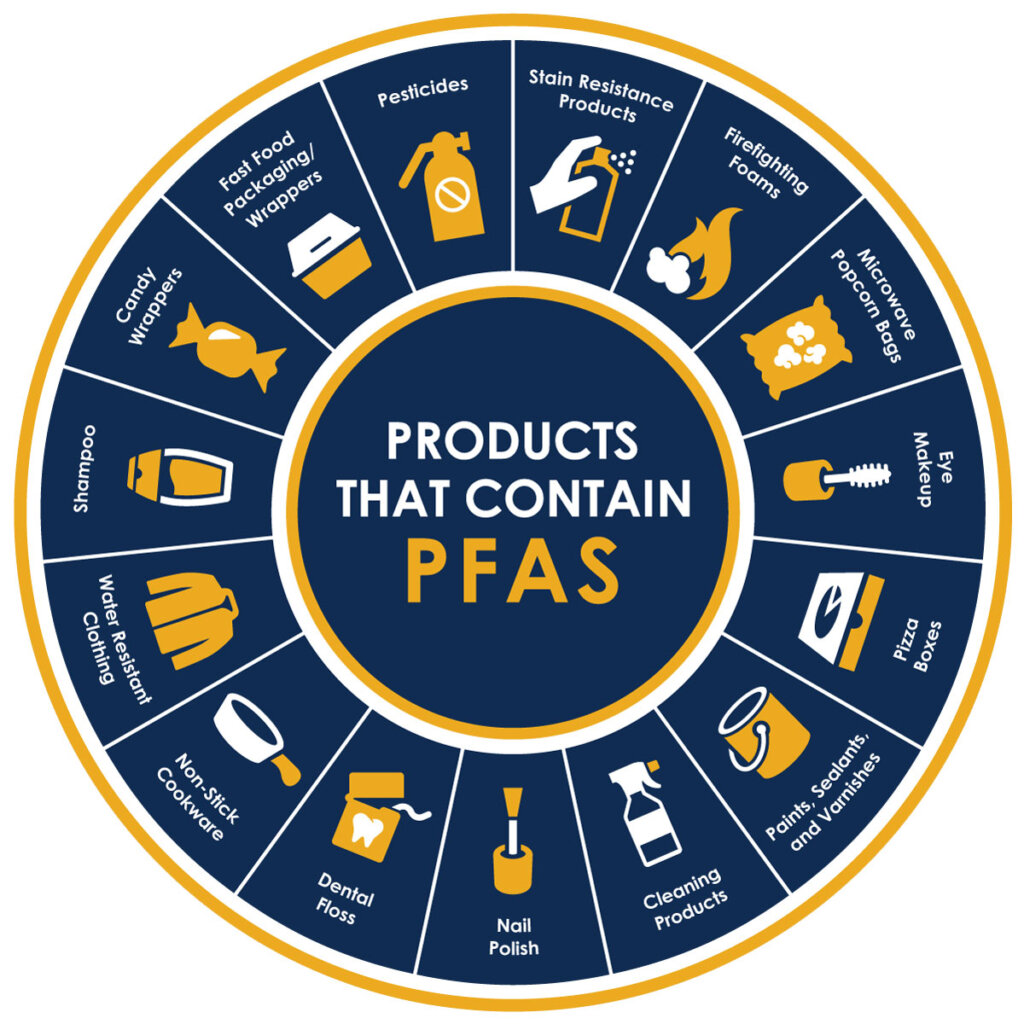Forever Chemicals Fixed with Particle Physics?
Friday Read and Watershed Issues | pfas and water treatment | March 2024
Ashley Johnson, Education and Outreach Coordinator
What is a forever chemical?
Forever chemical is a term that generally gets used for chemicals that cannot be broken down through natural processes. Much like plastic in a landfill, these chemicals can accumulate in the environment, and bioaccumulate (which is a build up of chemicals in organic tissue like mercury in fish).
One such group of forever chemicals has been receiving increased interest recently: PFAS, a term for perfluoroalkyl and polyfluoroalkyl substances, a group including thousands of chemical compounds1. PFAS are made up of chemical chains of connected carbon. Part of the reason PFAS are so effective (and difficult to break down) is because these carbon chains also include carbon – fluorine (C – F) bonds. C – F bonds are one of the strongest bonds in chemistry; when biological treatments are applied they tend to break the carbon – carbon chains, leading to shortened versions of the original PFAS compounds2.

These water-soluble chemical compounds came into use in the 1950s due to their ability to resist heat, oil, stains, grease and water. They are widely used in nonstick cookware, stain protection on clothing, food wrappers, adhesives, insulating electrical wire, furniture and more. Historically, they were also used in fire-suppressants3.

PFAS and Drinking Water
Concern about PFAS as a potential threat to water quality has been emerging with their detection in drinking water4,5. Information on how PFAS can impact human health is limited, but may affect organs such as the liver, kidney and thyroid, as well as the immune system and reproductive health6. The potential health risks are often documented to be linked with other chemicals and causes which makes it difficult to determine the exact implications of PFAS exposure.
Some countries have released regulatory limits for PFAS in drinking water, and while Canda does not currently have one in place, a draft objective is available online. However, some of the PFAS have been prohibited from manufacture and use. While there has been limited sampling for PFAS in water in Canada, most sites sampled were below levels of concern.

Our usual methods for treating drinking water can’t tackle the removal of PFAS, but researchers have been working on alternative methods including activated carbon, anion-exchange resins, and high-pressure membrane systems2,7. Unfortunately, most of these methods concentrate the PFAS info a form that needs to be further treated or disposed of. A potential solution that does completely break down the PFAS has recently been discovered, and strangely enough it comes from Fermilab.
Particle Physics Fix?
Fermilab is a particle physics and accelerator lab that hosts experiments advancing particle physics research8. You may have heard of them in relation to their contributions to the Large Hadron Collider in Europe. They have also been involved in quantum science, artificial intelligence, machine learning, dark matter and dark energy. So, what do they have to do with water?
Recently, scientists at Fermilab teamed up with 3M (of adhesive fame) to see if an innovative approach using the irradiation of PFAS with an electron beam could be used as a water treatment method9. Electric or magnetic fields are used to accelerate electrons to increase their energy; once enough energy has been accumulated the electrons are shot in a beam to irradiate the water sample. The C – F bond that makes PFAS so resistant to breaking down can elude most biological breakdown methods, but couldn’t withstand the electron beam. An important aspect of this experiment was to see if any hazardous products were released into the air or created as a by-product.
Results were positive: the PFAS were completely broken down into non-hazardous pieces, and no harmful by-products were created.
Learn More:
1 CDC PFAS Factsheet
2 Removal of poly- and perfluoroalkyl substances (PFAS) from water by adsorption: Role of PFAS chain length, effect of organic matter and challenges in adsorbent regeneration
3 Our current understanding of the human health and environmental risks of PFAS
4 PFAS in drinking water: an emergent water quality threat
5 Human exposure to per- and polyfluoroalkyl substances (PFAS) through drinking water: A review of the recent scientific literature
6 Draft Objective for per- and polyfluoroalkyl substances in Canadian drinking water: Overview
7 Occurrence of per- and polyfluoroalkyl substances (PFAS) in source water and their treatment in drinking water
8 Fermi National Accelerator Laboratory
9 Researchers at Fermilab use electron beams to eradicate forever chemicals in water

